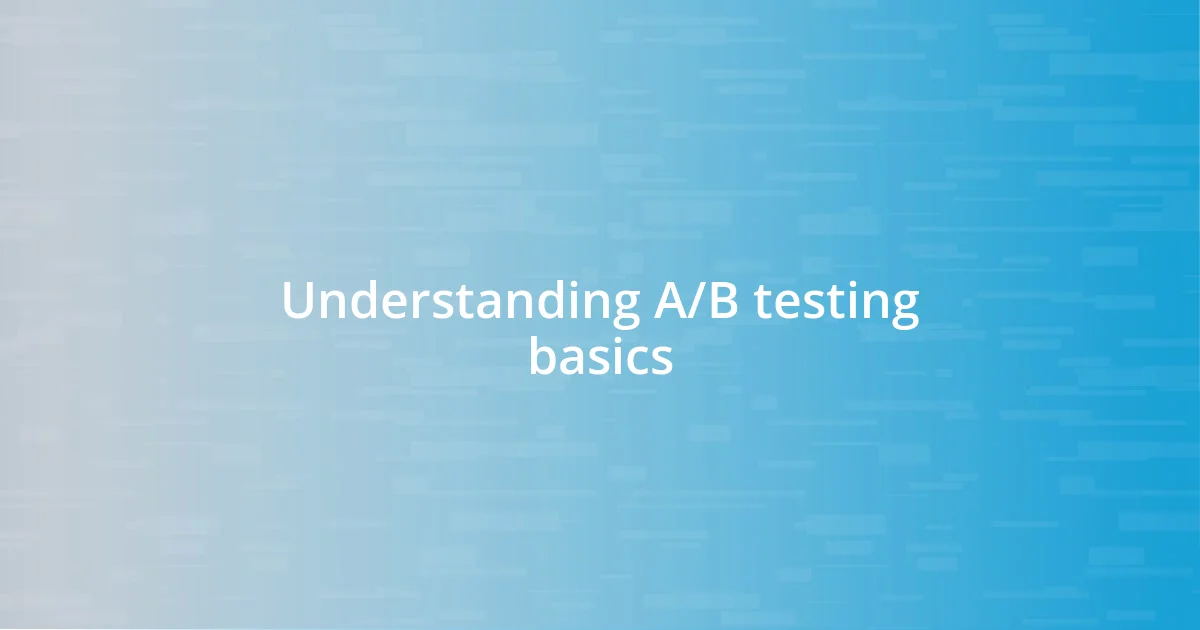Key takeaways:
- Clearly define your goals and ensure they align with your testing objectives to avoid wasted effort.
- Avoid common pitfalls like cherry-picking data and neglecting external factors that can skew results.
- Select the right A/B testing tools and integrate analytics for deeper insights into your data.

Understanding A/B testing basics
A/B testing is essentially a method of comparing two versions of a webpage, email, or other content to see which one performs better. Think of it as a friendly competition where your ideas go head-to-head, allowing you to make data-driven decisions rather than guessing what might work. I still remember the thrill of seeing my first A/B test results come in; it was like unwrapping a surprise gift!
It’s crucial to define your goals clearly before diving into A/B testing. Are you aiming to increase conversions, click-through rates, or engagement? I wasted a lot of time on tests that didn’t align with my objectives, and it taught me that clarity is key. Have you ever made a decision only to find out later that it didn’t really address your needs? That’s the value of setting a focused goal.
Another important aspect is to ensure that your sample size is sufficient for meaningful results. I once ran a test with too few participants, and the results were inconclusive. It felt disappointing, almost like training for a race and then realizing you overlooked the entry requirements! Remember, the more data you gather, the more reliable your insights will be.

Common pitfalls in A/B testing
When it comes to A/B testing, one of the most common pitfalls is cherry-picking data to support a preconceived notion. I’ve been there—after running a test, I was so excited about some initial results that I ignored the overall data. It felt like trying to fit a square peg into a round hole. To ensure you’re making decisions based on the whole picture, it’s essential to consider the overall performance, rather than just those shiny metrics that catch your eye.
Another major hurdle is neglecting to account for external factors. Once, I launched a campaign right before a holiday, and the results skewed dramatically because user behavior shifted during that time. It’s like trying to analyze a game when the weather changes unexpectedly! To help avoid these issues, here are some best practices to consider:
- Define your metrics before launching tests.
- Run tests for a sufficient duration to gather reliable insights.
- Avoid making changes based on incomplete data.
- Ensure that your sample size is large enough to be statistically significant.
- Be mindful of external events that could impact your results.
These errors can diminish the value of your insights, so learning from my experiences can help you sidestep potential pitfalls.

Tools for conducting A/B tests
When it comes to A/B testing, having the right tools can make all the difference. I’ve used platforms like Optimizely and Google Optimize, which truly simplify the process. With their user-friendly interfaces, it’s almost like having a trusty guide by your side, ensuring you don’t get lost in the data jungle.
One time, I decided to give VWO (Visual Website Optimizer) a shot. The ease with which I built my experiments felt empowering. I still remember the moment I launched my test and watched real-time results pour in—it was exhilarating! Choosing the right tool really enhances the experience. You might wonder, how do you know which one suits your needs? I found that most platforms offer free trials, letting you explore without commitment.
Integrating analytics tools like Google Analytics can take your A/B testing to the next level. They help you dig deeper into your data and connect the dots between different metrics. I learned this the hard way when I failed to incorporate analytics into my testing process—I missed critical insights that could have shaped my strategies. Remember, good tools not only aid in conducting tests but also amplify the insights you gather from them.














